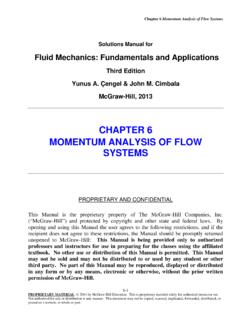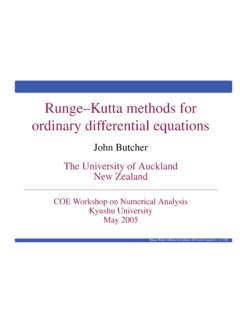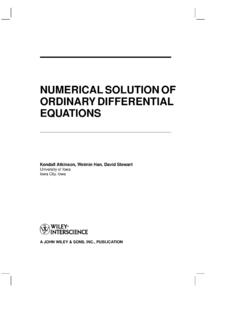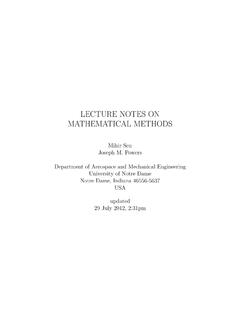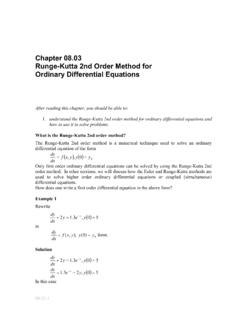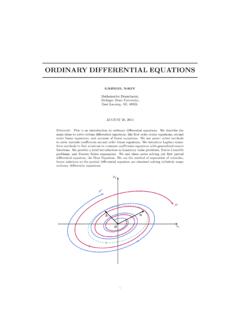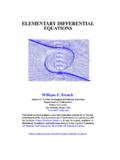Transcription of Chapter 2 Ordinary Differential Equations
1 Chapter 2 Ordinary Differential Equations Chapter 2 Ordinary Differential Equations Chapter 2 Ordinary Differential Equations Chapter 2 Ordinary Differential Equations Basic concepts, definitions, notations and classification Introduction modeling in engineering Differential equation - Definition Ordinary Differential equation (ODE) Partial Differential Equations (PDE) Differential operator D Order of DE Linear operator Linear and non-linear DE Homogeneous ODE Non-homogeneous ODE Normal form of nth order ODE Solution of DE Ansatz Explicit solution (implicit solution integral)
2 Trivial solution Complete solution General solution Particular solution Integral curve Initial Value Problem Boundary Value Problem Types of Boundary Conditions: I) boundary condition of the Ist kind (Dirichlet boundary condition II) boundary condition of the IInd kind (Neumann boundary condition) III) boundary condition of the IIIrd kind (Robin or mixed boundary condition) Well-posed or ill-posed BVP Uniqueness of solution Singular point First order ODE Normal and Standard Differential forms Picard s Theorem (existence and uniqueness of the solution of IVP)
3 Exact ODE Exact Differential Potential function Exact Differential equation Test on exact Differential Solution of exact equation Equations Reducible to Exact - Integrating Factor Integrating factor Suppressed solutions Reduction to exact equation Separable Equations Separable equation Solution of separable equation Chapter 2 Ordinary Differential Equations Homogeneous Equations Homogeneous function Homogeneous equation Reduction to separable equation substitution Homogeneous functions in nR Linear 1st order ODE General solution Solution of IVP Special Equations Bernoulli Equation Ricatti equation Clairaut equation Lagrange equation Equations solvable for y Applications of first order ODE
4 1. Orthogonal trajectories Family of trajectories Slope of tangent line Orthogonal lines Orthogonal trajectories Algorithm Approximate and Numerical methods for 1st order ODE Direction field method of isoclines Euler s Method, modified Euler method The Runge-Kutta Method Picard s Method of successive approximations Newton s Method (Taylor series solution) Linearization Equations of reducible order 1.
5 The unknown function does not appear in an equation explicitly 2. The independent variable does not appear in the equation explicitly (autonomous equation) 3. Reduction of the order of a linear equation if one solution is known Theory of Linear ODE Linear ODE Initial Value Problem Existence and uniqueness of solution of IVP 2 Homogeneous linear ODE Linear independent sets of functions Wronskian Solution space of 0=yLn Fundamental set Complimentary solution Chapter 2 Ordinary Differential Equations Non-Homogeneous linear ODE General solution of ()
6 XfyLn= Superposition principle Fundamental set of linear ODE with constant coefficients Particular solution of linear ODE Variation of parameter Undetermined coefficients Euler-Cauchy Equation Power Series Solutions Introduction Basic definitions and results Ordinary points Binomial coefficients etc. Some basic facts on power series Real analytic functions The power series method Existence and uniqueness of solutions Analyticity of the solutions Determining solutions The Method of Frobenius Introduction Singular points The solution method The Bessel functions Exercises Chapter 2 Ordinary Differential Equations Basic concepts, definitions.
7 Notations and classification Engineering design focuses on the use of models in developing predictions of natural phenomena. These models are developed by determining relationships between key parameters of the problem. Usually, it is difficult to find immediately the functional dependence between needed quantities in the model; at the same time, often, it is easy to establish relationships for the rates of change of these quantities using empirical laws. For example, in heat transfer, directional heat flux is proportional to the temperature gradient (Fourier s Law) dxdTkq = where the coefficient of proportionality is called the coefficient of conductivity. Also, during light propagation in the absorbing media, the rate of change of intensity I with distance is proportional to itself (Lambert s Law) kIdsdI = where the coefficient of proportionality is called the absorptivity of the media.
8 In another example, if we are asked to derive the path ()tx of a particle of mass m moving under a given time-dependent force ()tf, it is not easy to find it directly, however, Newton s second law (acceleration is proportional to the force) gives a Differential equation describing this motion. ()()tfdttxdm22= The solution of which gives an opportunity to establish the dependence of path on the acting force. The basic approach to deriving models is to apply conservation laws and empirical relations for control volumes. In most cases, the governing equation for a physical model can be derived in the form of a Differential equation. The governing Equations with one independent variable are called Ordinary Differential Equations . Because of this, we will study the methods of solution of Differential Equations .
9 Differential equation Definition 1 A Differential equation is an equation, which includes at least one derivative of an unknown function. Example 1: a) ()()xexxydxxdy=+2 b) ()xyyysin2= + c) ()()0,,2222= + yyxuxyxu d) ()()0y,..,y,y,xFn= e) ()()0xt,xuvxt,xu22= If a Differential equation (DE) only contains unknown functions of one variable and, consequently, only the Ordinary derivatives of unknown functions, then this equation is said to be an Ordinary Differential equation (ODE); in a case where other variables are included in the Differential equation, but not the derivatives with respect to these variables, the equation can again be treated as an Ordinary Differential equation in which other variables are considered to be parameters.
10 Equations with partial derivatives are called partial Differential Equations Chapter 2 Ordinary Differential Equations (PDE). In Example 1, Equations a),b) and d) are ODE s, and equation c) is a PDE; equation e) can be considered an Ordinary Differential equation with the parameter t. Differential operator D It is often convenient to use a special notation when dealing with Differential Equations . This notation called Differential operators, transforms functions into the associated derivatives. Consecutive application of the operator D transforms a differentiable function ()xf into its derivatives of different orders: ()()dxxdfxf=D ff :D ()()222 Ddxxfdxf= ff :D2 # A single operator notation D can be used for application of combinations of operators; for example, the operator DDbaDn+= implies ()() ()()()dxxdfbdxxfdaxfbxfaxDfnnn+=+=DD Order of DE The order of DE is the order of the highest derivative in the DE.




